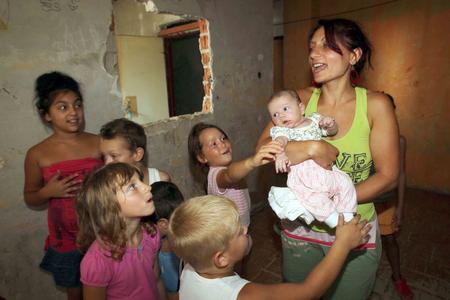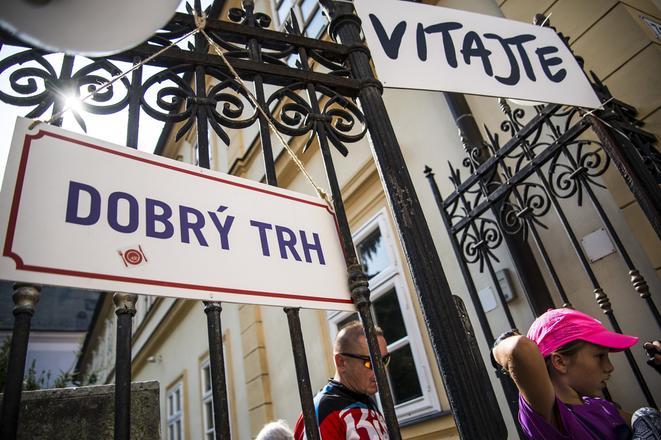A glossary of words as well as exercise related to this article are also published online.
Every summer, the open-air theatre in Banská Bystrica is one of the centres of social and cultural life in the city, and thousands of visitors come to attend the events that take place there. But it has not always been so – and the amphitheatre could easily have ended up in ruins.
That did not happen thanks to a group of high-school kids who decided to save the amphitheatre. They won a grant from the Healthy City Community Foundation (KNZM) and used it to run a campaign to save the amphitheatre.
“They negotiated with the municipal councillors, bureaucrats, they gained more resources, and it is due to them that today there is a functioning amphitheatre in Banská Bystrica,” Beata Hirt from the KNZM told The Slovak Spectator.
In Slovakia, civil activism has taken a while to grow but in recent years, initiatives like the one of the Banská Bystrica students have mushroomed around the country. Various civic associations help cultivate people in all regions of Slovakia, support them in their activities or even help them open up to foreigners.
Help and knowledge on both sides
An example of opening up to strangers is the case of Pokoj a Dobro (Peace and Good), an organisation in the western Slovak city of Nitra that helps turn the local community into a home for the Assyrian Christians from Iraq, who came to Slovakia as refugees.
The question of refugees arriving to the local community opened a very emotional discussion at the beginning but once the refugees arrived, the public discourse became much more practical and matter-of-fact.

“After meeting them, many people reconsidered their attitudes,” Peter Brenkus told The Slovak Spectator. “Thanks to the people who came, many inhabitants of Slovakia started to perceive conflicts in the Middle East as something much more concrete, not just something on their TV screens.”
When refugees started arriving to Europe in large numbers in 2015, people at Pokoj a Dobro were well aware of the fact that neither their civic association nor the European Union as a whole were able to effectively help all the refugees, so they set out priorities: to help the most vulnerable, to start with those who were likely to integrate well, and to make sure their stay in the country was practically feasible, says Brenkus.
The community also succeeded setting up a legislative environment in such a way that it would be easier for a bigger group of asylum seekers to complete the integration process if needed in future.
Good market for the capital
While Pokoj a Dobro tries to open up a local community to outsiders in an attempt to integrate them, there are other initiatives around the country that realise that members of local communities need to open up to each other. One such project is Dobrý Trh (Good Market), which revives urban public space and at the same time supports small producers and quality domestic products, as well as products of diverse ethnic cultures.
Illah Van Oijen and Barbara Zavarská organised the first market in 2011, and all the events that followed helped cultivate a sustainable lifestyle in Bratislava, and help revive the areas where they take place (Jakubovo Square, Panenská Street, the Old Market Hall), and have become a place for people to meet.
“The original idea of the Good Market was to point out that urban structure is viable and that it is important to go shopping to the city instead of to shopping malls, and to enjoy public urban space,” Zavarská stated.
They work with smaller companies and give space to startup brands that have potential for further development and the ability to function professionally and sustainably in the long-term, said Van Oijen.
Good ideas around Slovakia
The civic association Iskierka (Twinkle), was established in 1998 in Trnava, helping disabled children integrate into everyday life. As small children grow into young adults, Iskierka decided to realise a daycare centre named Comitas, and they opened it this September.
“The aim of this daycare centre is to provide a service that results in promoting and maintaining an active life and extension of self-sufficiency of its users,” explained Iskierka, adding that they try to facilitate a dignified life for their clients in a natural environment and lighten the load of the families that care for a dependant person. However, they still stay in a comfortable, homey environment.
In central Slovakia, civic associations and initiatives with good ideas can get the support of the Healthy City Community Foundation (KNZM), which aims to connect sources with the needs of the community in Banská Bystrica and Zvolen regions, according to Beata Hirt, director of KNZM.
“In the early 1990s we consider it a success that we helped people to realize and believe that they can change many situations by themselves, that they do not need to wait for bureaucrats or permits,” said Beata Hirt.
As an example she mentioned young parkourists, who started as a group of boys from the street who were able to organise their first parkour meeting thanks to a grant. Now, as a civic association, they focus on children and youth and organize international parkour meetings.
By the end of the 1990s, KNZM was one of the first community foundations to support Roma initiatives.
“It is safe to say that the support of the community foundation contributed to the emergence and development of several Roma organisations and their leaders in our region,” Hirt said.
The Spectator College is a programme designed to support the study and teaching of English in Slovakia, as well as to inspire interest in important public issues among young people. The project was created by The Slovak Spectator in cooperation with their exclusive partner – the Leaf Academy.

